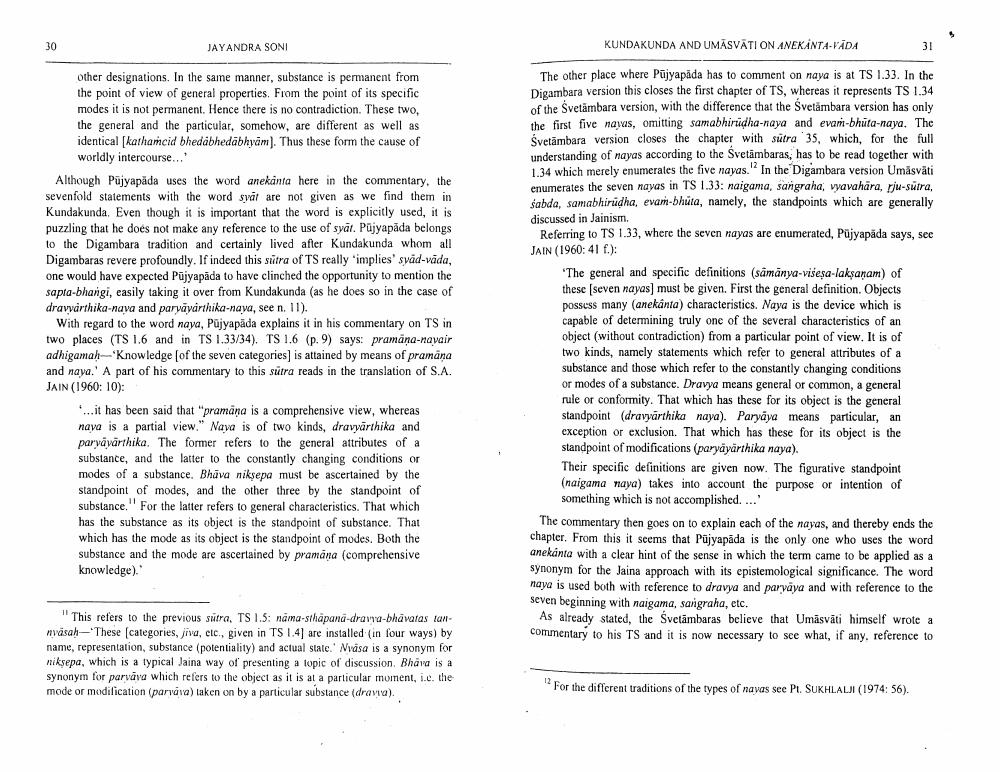________________
30
JAYANDRA SONI
other designations. In the same manner, substance is permanent from the point of view of general properties. From the point of its specific modes it is not permanent. Hence there is no contradiction. These two, the general and the particular, somehow, are different as well as identical [kathamcid bhedabhedabhyam]. Thus these form the cause of worldly intercourse..."
Although Pujyapada uses the word anekanta here in the commentary, the sevenfold statements with the word syat are not given as we find them in Kundakunda. Even though it is important that the word is explicitly used, it is puzzling that he does not make any reference to the use of syat. Pujyapada belongs to the Digambara tradition and certainly lived after Kundakunda whom all Digambaras revere profoundly. If indeed this sutra of TS really implies' syād-vāda, one would have expected Pujyapada to have clinched the opportunity to mention the sapta-bhangi, easily taking it over from Kundakunda (as he does so in the case of dravyarthika-naya and paryayarthika-naya, see n. 11).
With regard to the word naya, Pujyapada explains it in his commentary on TS in two places (TS 1.6 and in TS 1.33/34). TS 1.6 (p. 9) says: pramāṇa-nayair adhigamaḥ Knowledge [of the seven categories] is attained by means of pramāņa and naya.' A part of his commentary to this sutra reads in the translation of S.A. JAIN (1960: 10):
...it has been said that "pramana is a comprehensive view, whereas naya is a partial view." Naya is of two kinds, dravyarthika and paryāyārthika. The former refers to the general attributes of a substance, and the latter to the constantly changing conditions or modes of a substance. Bhava nikṣepa must be ascertained by the standpoint of modes, and the other three by the standpoint of substance." For the latter refers to general characteristics. That which has the substance as its object is the standpoint of substance. That which has the mode as its object is the standpoint of modes. Both the substance and the mode are ascertained by pramāna (comprehensive knowledge).
11 This refers to the previous sutra, TS 1.5: nama-sthapana-dravya-bhavatas tannväsaḥ These [categories, jiva, etc., given in TS 1.4] are installed (in four ways) by name, representation, substance (potentiality) and actual state. Nvasa is a synonym for nikṣepa, which is a typical Jaina way of presenting a topic of discussion. Bhava is a synonym for parväva which refers to the object as it is at a particular moment, i.e. the mode or modification (parváva) taken on by a particular substance (dravya).
KUNDAKUNDA AND UMASVATI ON ANEKANTA-VĀDA
The other place where Pujyapada has to comment on naya is at TS 1.33. In the Digambara version this closes the first chapter of TS, whereas it represents TS 1.34 of the Svetambara version, with the difference that the Svetambara version has only the first five nayas, omitting samabhirudha-naya and evam-bhūta-naya. The Svetambara version closes the chapter with sutra 35, which, for the full understanding of nayas according to the Svetämbaras, has to be read together with 1.34 which merely enumerates the five nayas."2 In the Digambara version Umäsväti enumerates the seven nayas in TS 1.33: naigama, sangraha, vyavahāra, rju-sūtra, sabda, samabhirudha, evam-bhuta, namely, the standpoints which are generally discussed in Jainism.
Referring to TS 1.33, where the seven nayas are enumerated, Pujyapada says, see JAIN (1960: 41 f.):
'The general and specific definitions (samanya-viseṣa-lakṣaṇam) of these [seven nayas] must be given. First the general definition. Objects possess many (anekanta) characteristics. Naya is the device which is capable of determining truly one of the several characteristics of an object (without contradiction) from a particular point of view. It is of two kinds, namely statements which refer to general attributes of a substance and those which refer to the constantly changing conditions or modes of a substance. Dravya means general or common, a general rule or conformity. That which has these for its object is the general standpoint (dravyarthika naya). Paryaya means particular, an exception or exclusion. That which has these for its object is the standpoint of modifications (paryayarthika naya).
Their specific definitions are given now. The figurative standpoint (naigama naya) takes into account the purpose or intention of something which is not accomplished. ...'
31
The commentary then goes on to explain each of the nayas, and thereby ends the chapter. From this it seems that Pujyapada is the only one who uses the word anekanta with a clear hint of the sense in which the term came to be applied as a synonym for the Jaina approach with its epistemological significance. The word naya is used both with reference to dravya and paryaya and with reference to the seven beginning with naigama, sangraha, etc.
As already stated, the Svetambaras believe that Umasvati himself wrote a commentary to his TS and it is now necessary to see what, if any, reference to
12
For the different traditions of the types of nayas see Pt. SUKHLALJI (1974: 56).




